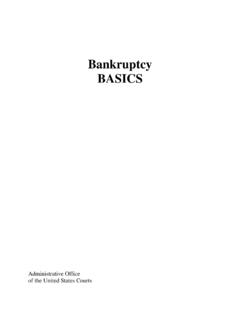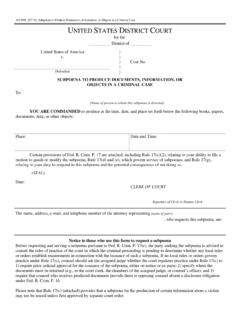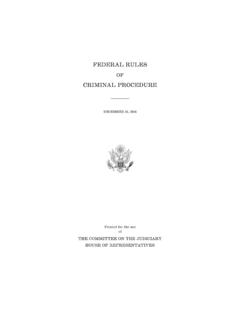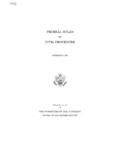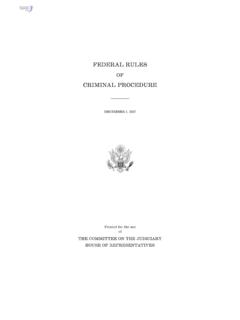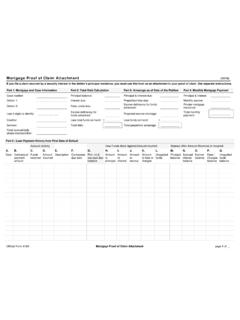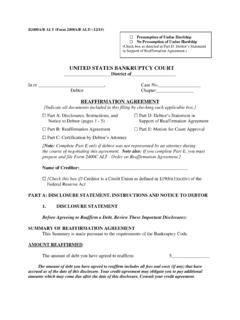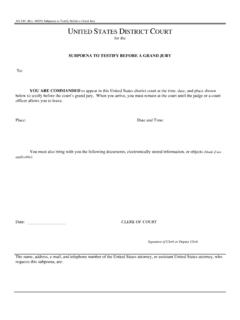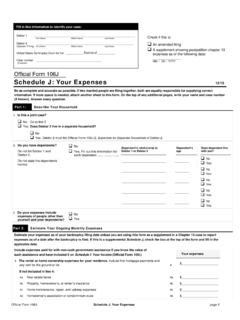Transcription of RULES GOVERNING SECTION 2254 CASES ... - United States …
1 RULES GOVERNING SECTION 2254 CASES IN THE United States DISTRICT COURTS and RULES GOVERNING SECTION 2255 PROCEEDINGS FOR THE United States DISTRICT COURTS Effective Feb. 1, 1977, as amended to Dec. 1, 2019 TABLE OF CONTENTS Page RULES (2254 CASES ) Rule 1: Scope .. 1 Rule 2: The Petition .. 1 Rule 3: Filing the Petition; Inmate Filing .. 2 Rule 4: Preliminary Review; Serving the Petition and Order .. 3 Rule 5: The Answer and the Reply .. 3 Rule 6: Discovery .. 4 Rule 7: Expanding the Record .. 4 Rule 8: Evidentiary Hearing .. 5 Rule 9: Second or Successive Petitions .. 6 Rule 10: Powers of a Magistrate Judge .. 6 Rule 11: Certificate of Appealability; Time to Appeal.
2 6 Rule 12: Applicability of the Federal RULES of Civil Procedure .. 7 RULES (2255 PROCEEDINGS) Rule 1: Scope .. 8 Rule 2: The Petition .. 8 Rule 3: Filing the Petition; Inmate Filing .. 9 Rule 4: Preliminary Review; Serving the Petition and Order .. 10 Rule 5: The Answer and the Reply .. 10 Rule 6: Discovery .. 11 Rule 7: Expanding the Record .. 11 Rule 8: Evidentiary Hearing .. 12 Rule 9: Second or Successive Petitions .. 12 Rule 10: Powers of a Magistrate Judge .. 13 Rule 11: Certificate of Appealability; Time to Appeal .. 13 Rule 12: Applicability of the Federal RULES of Civil Procedure .. 13 (1) RULES GOVERNING SECTION 2254 CASES IN THE United States DISTRICT COURTS Effective Feb. 1, 1977, as amended to Dec.
3 1, 2019 Rule 1. Scope (a) CASES Involving a Petition under 28 2254. These RULES govern a petition for a writ of habeas corpus filed in a United States district court under 28 2254 by: (1) a person in custody under a state-court judgment who seeks a determination that the custody violates the Constitu-tion, laws, or treaties of the United States ; and (2) a person in custody under a state-court or federal-court judgment who seeks a determination that future custody un-der a state-court judgment would violate the Constitution, laws, or treaties of the United States . (b) Other CASES . The district court may apply any or all of these RULES to a habeas corpus petition not covered by Rule 1(a).
4 Rule 2. The Petition (a) Current Custody; Naming the Respondent. If the peti-tioner is currently in custody under a state-court judgment, the pe-tition must name as respondent the state officer who has custody. (b) Future Custody; Naming the Respondents and Speci-fying the Judgment. If the petitioner is not yet in custody - but may be subject to future custody - under the state-court judgment being contested, the petition must name as respondents both the officer who has current custody and the attorney general of the state where the judgment was entered. The petition must ask for relief from the state-court judgment being contested. (c) Form. The petition must: (1) specify all the grounds for relief available to the pe-titioner; (2) state the facts supporting each ground; (3) state the relief requested; (4) be printed, typewritten, or legibly handwritten; and RULES GOVERNING SECTION 2254 CASES AND SECTION 2255 PROCEEDINGS (2) (5) be signed under penalty of perjury by the petitioner or by a person authorized to sign it for the petitioner under 28 2242.
5 (d) Standard Form. The petition must substantially follow either the form appended to these RULES or a form prescribed by a local district-court rule. The clerk must make forms available to petitioners without charge. (e) Separate Petitions for Judgments of Separate Courts. A petitioner who seeks relief from judgments of more than one state court must file a separate petition covering the judgment or judgments of each court. Rule 3. Filing the Petition; Inmate Filing (a) Where to File; Copies; Filing Fee. An original and two copies of the petition must be filed with the clerk and must be ac-companied by: (1) the applicable filing fee, or (2) a motion for leave to proceed in forma pauperis, the affidavit required by 28 1915, and a certificate from the warden or other appropriate officer of the place of confinement showing the amount of money or securities that the petitioner has in any account in the institution.
6 (b) Filing. The clerk must file the petition and enter it on the docket. (c) Time to File. The time for filing a petition is governed by 28 2244(d). (d) Inmate Filing. A paper filed by an inmate confined in an institution is timely if deposited in the institution's internal mailing system on or before the last day for filing. If an institution has a system designed for legal mail, the inmate must use that system to receive the benefit of this rule. Timely filing may be shown by a declaration in compliance with 28 1746 or by a notarized statement, either of which must set forth the date of deposit and state that first-class postage has been prepaid. RULES GOVERNING SECTION 2254 CASES AND SECTION 2255 PROCEEDINGS (3) Rule 4.
7 Preliminary Review; Serving the Petition and Order The clerk must promptly forward the petition to a judge under the court's assignment procedure, and the judge must promptly ex-amine it. If it plainly appears from the petition and any attached exhibits that the petitioner is not entitled to relief in the district court, the judge must dismiss the petition and direct the clerk to notify the petitioner. If the petition is not dismissed, the judge must order the respondent to file an answer, motion, or other re-sponse within a fixed time, or to take other action the judge may order. In every case, the clerk must serve a copy of the petition and any order on the respondent and on the attorney general or other appropriate officer of the state involved.
8 Rule 5. The Answer and the Reply (a) When Required. The respondent is not required to an-swer the petition unless a judge so orders. (b) Contents: Addressing the Allegations; Stating a Bar. The answer must address the allegations in the petition. In addi-tion, it must state whether any claim in the petition is barred by a failure to exhaust state remedies, a procedural bar, non- retroac-tivity, or a statute of limitations. (c) Contents: Transcripts. The answer must also indicate what transcripts (of pretrial, trial, sentencing, or post-conviction proceedings) are available, when they can be furnished, and what proceedings have been recorded but not transcribed. The respond-ent must attach to the answer parts of the transcript that the re-spondent considers relevant.
9 The judge may order that the re-spondent furnish other parts of existing transcripts or that parts of untranscribed recordings be transcribed and furnished. If a tran-script cannot be obtained, the respondent may submit a narrative summary of the evidence. (d) Contents: Briefs on Appeal and Opinions. The re-spondent must also file with the answer a copy of: RULES GOVERNING SECTION 2254 CASES AND SECTION 2255 PROCEEDINGS (4) (1) any brief that the petitioner submitted in an appellate court contesting the conviction or sentence, or contesting an ad-verse judgment or order in a post-conviction proceeding; (2) any brief that the prosecution submitted in an appel-late court relating to the conviction or sentence; and (3) the opinions and dispositive orders of the appellate court relating to the conviction or the sentence.
10 (e) Reply. The petitioner may file a reply to the respondent's answer or other pleading. The judge must set the time to file unless the time is already set by local rule. Rule 6. Discovery (a) Leave of Court Required. A judge may, for good cause, authorize a party to conduct discovery under the Federal RULES of Civil Procedure and may limit the extent of discovery. If necessary for effective discovery, the judge must appoint an attorney for a petitioner who qualifies to have counsel appointed under 18 3006A. (b) Requesting Discovery. A party requesting discovery must provide reasons for the request. The request must also in-clude any proposed interrogatories and requests for admission, and must specify any requested documents.
